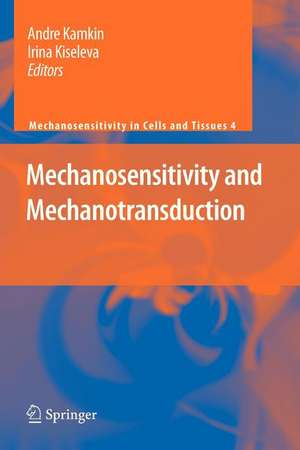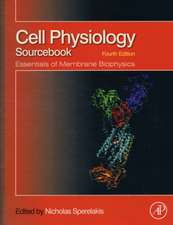Mechanosensitivity and Mechanotransduction: Mechanosensitivity in Cells and Tissues, cartea 4
Editat de Andre Kamkin, Irina Kiselevaen Limba Engleză Paperback – 2 ian 2013
mechanotransduction in different cells and tissues. Mechanosensitivity and mechanotransduction
of the heart and vascular cells, in the lung, in bone and joint tissues, in sensor systems and in blood cells are described in detail. This Volume focuses on molecular mechanisms of mechanosensitivity and mechanotransduction via cytoskeleton. Integrin-mediated mechanotransduction, the role of actin cytoskeleton and the role of other cytoskeletal elements are discussed. It contains a detailed description of several stretch-induced signaling cascades with multiple levels of crosstalk between different pathways. It contains a description of the role of nitric oxide in regulation of cardiac activity and in regulation of mechanically gated channels in the heart. In the heart mechanical signals are propagated into the intracellular space primarily via integrin-linked complexes, and are subsequently transmitted from cell to cell via paracrine signaling. Biochemical signals derived from mechanical stimuli activate both acute phosphorylation of signaling cascades, such as in the PI3K, FAK, and ILK pathways, and long-term morphological modii cations via intracellular cytoskeletal reorganization and
extracellular matrix remodelling. Cellular and molecular effects of mechanical stretch on vascular cells are also discussed. This Volume highlights the role of mechanotransduction in the lung, in bone and joint tissues. For the first time mechanosensitivity and mechanotransduction in blood cells are discussed. It contains new insights into mechanosensitive K+ channels functioning in mouse B lymphocytes.
This book is a unique collection of reviews outlining current knowledge and future developments
in this rapidly growing field. Currently, investigations of the molecular mechanisms ofmechanosensitivity and mechanotransduction are focused on several issues. The majority of
studies investigate intracellular signaling pathways. Knowledge of the mechanisms which underlie these processes is necessary for understanding of the normal functioning of different organs and tissues and allows to predict changes, which arise due to alterations of their environment. Possibly such knowledge will allow the development of new methods of artificial intervention and therapies.
This book brings up the problem closer to the experts in related medical and biological sciences as well as practicing doctors besides just presenting the latest achievements in the field.
| Toate formatele și edițiile | Preț | Express |
|---|---|---|
| Paperback (1) | 1221.69 lei 6-8 săpt. | |
| SPRINGER NETHERLANDS – 2 ian 2013 | 1221.69 lei 6-8 săpt. | |
| Hardback (1) | 1227.99 lei 6-8 săpt. | |
| SPRINGER NETHERLANDS – 30 noi 2010 | 1227.99 lei 6-8 săpt. |
Preț: 1221.69 lei
Preț vechi: 1489.87 lei
-18% Nou
Puncte Express: 1833
Preț estimativ în valută:
233.78€ • 249.98$ • 194.91£
233.78€ • 249.98$ • 194.91£
Carte tipărită la comandă
Livrare economică 18 aprilie-02 mai
Preluare comenzi: 021 569.72.76
Specificații
ISBN-13: 9789400734326
ISBN-10: 9400734328
Pagini: 400
Ilustrații: XXIV, 371 p.
Dimensiuni: 155 x 235 x 21 mm
Greutate: 0.56 kg
Ediția:2011
Editura: SPRINGER NETHERLANDS
Colecția Springer
Seria Mechanosensitivity in Cells and Tissues
Locul publicării:Dordrecht, Netherlands
ISBN-10: 9400734328
Pagini: 400
Ilustrații: XXIV, 371 p.
Dimensiuni: 155 x 235 x 21 mm
Greutate: 0.56 kg
Ediția:2011
Editura: SPRINGER NETHERLANDS
Colecția Springer
Seria Mechanosensitivity in Cells and Tissues
Locul publicării:Dordrecht, Netherlands
Public țintă
ResearchCuprins
Foreword by Holger Scholz.- Editorial: Basic principles of mechanosensing and mechanotransduction in cells, Andre Kamkin and Irina Kiseleva.- List of Contributors.- Part I The Role of Cytoskeleton in Mechanosensitivity and Mechanotransduction: 1. Integrin-mediated mechanotransduction in vascular smooth muscle cells, Kay-Pong Yip, Lavanya Balasubramanian, James S. K. Sham.- 2. The role of actin cytoskeleton in mechanosensation, Tianzhi Luo and Douglas N. Robinson.- 3. Effect of Cytoskeleton on the Mechanosensitivity of Genes in Osteoblasts, Qiang Fu, Changjing Wu, Yourui Li, Yiping Zhang.- 4. Involvement of the cytoskeletal elements in articular cartilage mechanotransduction, Emma J Blain.- Part II Molecular Mechanisms of Mechanotransduction and Ion Channels Modifiers : 5. The role of nitric oxide in regulation of mechanically gated channels in the heart, Victor Kazanski, Andre Kamkin, Ekaterina Makarenko, Natalia Lysenko, Natalia Lapina, and Irina Kiseleva.- 6. Role of signaling pathways in the myocardial response to biomechanical stress and in mechanotransduction in the heart, Danny Guo, Zamaneh Kassiri, and Gavin Y. Oudit.- 7. Atomistic molecular simulation of gating modifier venom peptides - two binding modes and effects of lipid structure, Kazuhisa Nishizawa.- Part III Mechanosensing and Mechanotransduction in Vascular Cells: 8. Cellular and molecular effects of mechanical stretch on vascular cells, Kou-Gi Shyu.- 9. Role of Proteoglycans in Vascular Mechanotransduction, Aaron B. Baker.- Part IV Mechanotransduction in the Lung: 10. Control of TRPV4 and its effect on the lung, James C. Parker and Mary I Townsley.- 11. The Role of Protein-protein Interactions in Mechanotransduction: Implications in Ventilator Induced Lung Injury, Matt Rubacha and Mingyao Liu.- Part V Mechanosensing and Mechanotransduction in Bone and Joint Tissues: 12. Cellular mechanisms of mechanotransduction in bone, Suzanne R.L. Young and Fredrick M. Pavalko.- 13.The mechanosensitivity of cells in joint tissues: Role in the pathogenesis of joint diseases, Christelle Sanchez, Marianne Mathy-Hartert, Yves Henrotin.- Part VI Mechanosensitivity of Sensor Systems: 14. Primary Cilia are Mechanosensory Organelles in Vestibular Tissues, Surya Nauli.- Part VII Mechanosensing and Mechanotransduction in Blood Cells: 15. Mechanosensitive K+ Channels in Mouse B Lymphocytes: PLC-mediated Release of TREK-2 from Inhibition by PIP2, Sung Joon Kim and Joo Hyun Nam.- Index.
Textul de pe ultima copertă
This book presents the latest findings in the field of research of mechanosensitivity and
mechanotransduction in different cells and tissues. Mechanosensitivity and mechanotransduction
of the heart and vascular cells, in the lung, in bone and joint tissues, in sensor systems and in blood cells are described in detail. This Volume focuses on molecular mechanisms of mechanosensitivity and mechanotransduction via cytoskeleton. Integrin-mediated mechanotransduction, the role of actin cytoskeleton and the role of other cytoskeletal elements are discussed. It contains a detailed description of several stretch-induced signaling cascades with multiple levels of crosstalk between different pathways. It contains a description of the role of nitric oxide in regulation of cardiac activity and in regulation of mechanically gated channels in the heart. In the heart mechanical signals are propagated into the intracellular space primarily via integrin-linked complexes, and are subsequently transmitted from cell to cell via paracrine signaling. Biochemical signals derived from mechanical stimuli activate both acute phosphorylation of signaling cascades, such as in the PI3K, FAK, and ILK pathways, and long-term morphological modii cations via intracellular cytoskeletal reorganization and
extracellular matrix remodelling. Cellular and molecular effects of mechanical stretch on vascular cells are also discussed. This Volume highlights the role of mechanotransduction in the lung, in bone and joint tissues. For the first time mechanosensitivity and mechanotransduction in blood cells are discussed. It contains new insights into mechanosensitive K+ channels functioning in mouse B lymphocytes.
This book is a unique collection of reviews outlining current knowledge and future developments
in this rapidly growing field. Currently, investigations of the molecular mechanisms ofmechanosensitivity and mechanotransduction are focused on several issues. The majority of
studies investigate intracellular signaling pathways. Knowledge of the mechanisms which underlie these processes is necessary for understanding of the normal functioning of different organs and tissues and allows to predict changes, which arise due to alterations of their environment. Possibly such knowledge will allow the development of new methods of artificial intervention and therapies.
This book brings up the problem closer to the experts in related medical and biological sciences as well as practicing doctors besides just presenting the latest achievements in the field.
mechanotransduction in different cells and tissues. Mechanosensitivity and mechanotransduction
of the heart and vascular cells, in the lung, in bone and joint tissues, in sensor systems and in blood cells are described in detail. This Volume focuses on molecular mechanisms of mechanosensitivity and mechanotransduction via cytoskeleton. Integrin-mediated mechanotransduction, the role of actin cytoskeleton and the role of other cytoskeletal elements are discussed. It contains a detailed description of several stretch-induced signaling cascades with multiple levels of crosstalk between different pathways. It contains a description of the role of nitric oxide in regulation of cardiac activity and in regulation of mechanically gated channels in the heart. In the heart mechanical signals are propagated into the intracellular space primarily via integrin-linked complexes, and are subsequently transmitted from cell to cell via paracrine signaling. Biochemical signals derived from mechanical stimuli activate both acute phosphorylation of signaling cascades, such as in the PI3K, FAK, and ILK pathways, and long-term morphological modii cations via intracellular cytoskeletal reorganization and
extracellular matrix remodelling. Cellular and molecular effects of mechanical stretch on vascular cells are also discussed. This Volume highlights the role of mechanotransduction in the lung, in bone and joint tissues. For the first time mechanosensitivity and mechanotransduction in blood cells are discussed. It contains new insights into mechanosensitive K+ channels functioning in mouse B lymphocytes.
This book is a unique collection of reviews outlining current knowledge and future developments
in this rapidly growing field. Currently, investigations of the molecular mechanisms ofmechanosensitivity and mechanotransduction are focused on several issues. The majority of
studies investigate intracellular signaling pathways. Knowledge of the mechanisms which underlie these processes is necessary for understanding of the normal functioning of different organs and tissues and allows to predict changes, which arise due to alterations of their environment. Possibly such knowledge will allow the development of new methods of artificial intervention and therapies.
This book brings up the problem closer to the experts in related medical and biological sciences as well as practicing doctors besides just presenting the latest achievements in the field.
Caracteristici
One book provides a detailed description of molecular mechanisms of mechanosensing and mechanotransduction in different cells One book brings together a comprehensive outline of modern vision of structure and functions of cytoskeleton Gives a wide and detailed coverage of mechanosensitive ion channels Provides a wide and detailed description of various signaling pathways













